My Gettysburg 150 Experience
WARNING: This is a massive post, but I don’t feel like I can break it up. It’s going to take some time to read through.
I’ve LOVED Gettysburg since I was a kid. We went there a few times as a family and it was always cool. I have great memories of looking for monuments with my dad (especially these things called “flank markers”). I vividly remember learning what “battery” meant in an artillery context on one of those trips. There was even a time when my brother and I “found” bullets (that my dad had sneakily planted minutes before) at the Angle.
It’s a big part of the reason that I love history. Gettysburg was my first (and remains my strongest) historical love, but I’ve never REALLY experienced it. Not until this week anyway. Before last Wednesday, I had never been in Gettysburg on the anniversary of the battle. I’ve visited probably about 40 times, but never on those 3 days in July. I was always concerned about the crowds, or I had other things I had to do – there were a million excuses – but this year, for the 150th, I decided that I at least needed to go up for a day.
I agonized about which day to choose. I poured over the NPS website, and the schedule of events they had posted, looking for the most interesting collection of real-time tours and events. Much to my surprise, it looked like July 3 was going to be the winner.
I say it’s a surprise because the big event on July 3 – the big event of Gettysburg, period – is Pickett’s Charge. If Gettysburg were an album, “Pickett’s Charge” and “Lincoln’s Gettysburg Address” would be the singles. Everyone knows those. They’re always on the radio. As Gettysburg nerds (Gettysburg hipsters, perhaps?) we tend to like the B-sides: “Meredith Avenue“, “Culp’s Hill“, “The Bliss Farm“, and even the never-before-released “Neill Avenue“. We all know Pickett’s Charge and we feel like people who have that as their only impression of the fighting here are missing out on a lot. Boy am I glad I put those feelings aside for one day. But now I’m rushing ahead of myself, aren’t I?
When I decided that I did want to go for the anniversary this year, and I wanted to go on July 3, I called up my dad to see if he wanted to go with me. I told him what I wanted to see: the 10:30am East Cavalry Field walking tour, and the 3:00pm Pickett’s Charge. He was a little skeptical at first, but he put those feelings aside and worked his schedule so that he could be there.
He came down to Catonsville and picked me up that morning, and we got on the road to Gettysburg. I found out along the way that he had never been to the East Cavalry Field before, so I drove on the way up. We arrived a little before 10:00am, and it was PACKED. The tour was supposed to begin at the Michigan Monument, and since that’s closer to the Low Dutch Road, I took that route. Of course, the NPS had other ideas: the normally two-way Gregg Avenue had been converted to a one-way, and in the wrong direction for us. After snaking around the Low Dutch Road, up to Route 30 and back down, we got parked about a 1/2 mile from the Michigan Monument on Gregg Avenue and made it to the base of the monument just in time for Ranger Jared Frederick (and a steady rain) to begin.
The talk was a little more than an hour, and while full of good first-hand, personal accounts of the fighting and aftermath, I think the average visitor was left with the impression that this action was much more costly than it actually was. Not to take anything away from the men who fought there, but as Civil War battles go this wasn’t much more than a skirmish – it certainly wasn’t at the level of Pickett’s Charge in terms of bloodiness. The program also didn’t do a great job of explaining the movements and flow of the battle – a hard thing to do on the East Cavalry Field, I’ll grant – but somewhat disappointing for what was billed as a walking tour. At the same time, it was nice to see so many people (around 1,000, I’d say) out for a tour of one of the more esoteric parts of the battlefield. And the rangers did a MASTERFUL job organizing this tour and handling logistics. I should have immediately taken both of these as a good sign for things to come.
From East Cavalry, we started to head into town to find some lunch. Since we were coming in on the Hanover Road, I decided to stop off at another place my dad had never visited: Benner’s Hill. This is where the Confederate artillery that fired on Culp’s Hill and East Cemetery Hill was placed. Most visitors (like my dad) never bother to get the Confederate perspective on those actions. Doing so makes it pretty obvious why they failed.
Continuing in to town, traffic was a nightmare all the way to the diamond. We decided it would be much easier to grab a quick lunch on Route 30, so we made a few turns and grabbed some sandwiches east of town. By 1:00pm, we were back on the road and about to head down toward the visitor’s center to get parked in plenty of time for Pickett’s Charge – too early actually, as I thought about it. As we got off Route 15 at the Baltimore Pike, the rain had stopped completely and I asked my dad if he could handle a little adventure. He said, “Sure.”
I directed him to turn right onto Highland Avenue Road, and then take a left when we got to Clapsaddle Road. I didn’t tell him what we were going to see. I think the “Clapsaddle” name made him think that this was another cavalry-related site. Little did he know I was taking him to the ultimate of the Gettysburg “B-sides”.
When the road came to a dead end, I asked him to park on the left, and I grabbed my backpack full of water bottles and started looking for a trail. Now my dad got nervous. After a few moments, I found the start of the long-neglected trail (just look for the area between the “No Trespassing” signs) and led him down the hill to the southwest. Just before Rock Creek, the trail becomes much easier and takes a sharp left, heading up the northwest slope of Wolf Hill. Since you don’t see what you’re walking toward until you’re right on top of it, I was able to keep the surprise going – I was taking him to Neill Avenue.
Forget never being there – my dad had never even heard about it (how’s that for hipster, huh?). On the morning of July 3, 1863 (a little more than 150 years before our visit), Brig. General Thomas Neill led his brigade to the top of this ridge where they had a brief skirmish with members of the 2nd VA, trying to work their way around the Union right flank. Thus, Neill’s men became the right flank of the Union army at Gettysburg. Each of Neill’s regiments has a monument up there (except the 77th NY which stayed behind on Powers Hill). It’s an absolute shame that very few people visit them. By far, the coolest one is to the 7th ME Infantry:

Of course, the real treat on Neill Avenue is what’s at the top of the hill: the Right Flank Marker for the Army of the Potomac:
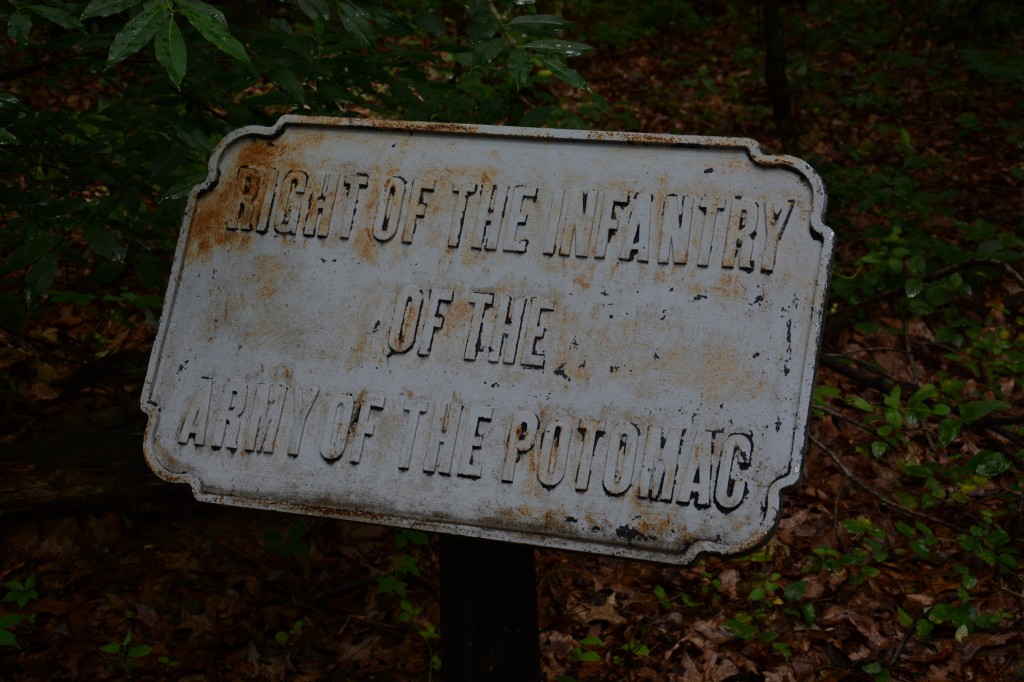
It was really nice to be able to visit this spot on the anniversary of the event here. We didn’t see another soul for the 45 minutes we were on the trail and up at Neill Avenue. It’s a really special place for that reason – even on one of the busiest days in the history of Gettysburg National Military Park, there are still a few places where you can have a solitary moment. At the same time, these men deserve to be remembered too, and I wish there was an easier way to allow people to visit this place.
We worked our way back up the trail, and drove back to the Baltimore Pike to try to park at the visitor’s center. It was just before 2:00pm, so we had almost an hour to get in-position for Pickett’s Charge. Every lot we passed was full. Even fields that were being used as temporary parking for the event were maxed out. I was getting nervous.
As we continued up the Baltimore Pike, we noticed that there were spots along the road. There were no parking restrictions posted, and we were within easy walking distance – just a few hundred yards north of Hunt Avenue. We pulled off and parked. I grabbed my water-filled backpack and the cameras, and we started walking.
As we came around the bend in the woods along Hunt Avenue, I got my first look at Cemetery Ridge that day. It was FILLED with people, and a steady stream of visitors – 6 people or more across – was making its way up the slope between the Leister House and the Meade Monument. I’d never seen so many people anywhere at Gettysburg before.
On top of the ridge, we found thousands of on-lookers with lawn chairs. There were satellite trucks for the news organizations covering the event. Temporary stages had been erected where Rangers and LBG’s were giving interviews and commentary to TV crews. And once again, a steady stream of people were heading west, walking across the fields to join up with the “Confederate” lines already forming on Seminary Ridge.
This is why I wanted to be here. The 3:00pm Pickett’s Charge event was to be a recreation of the famous attack, put on by park visitors lined up in the formations of the 9 brigades that made the charge, 150 years ago to the minute. If I didn’t participate in this, I at least wanted to see it. When we saw the line of people crossing the Emmitsburg Road to participate, my dad and I knew we wanted to go along, too. I led us down to the Angle, where a park ranger was helping people over the wall who wanted to go all the way across.
Before we reached the Emmitsburg Road, an older man was kneeling down along the trail. Since it was a hot day, my dad became concerned that perhaps this man was having a medical issue. He reached down and asked the man if he needed help. The man explained that he was praying. He had an ancestor who had participated in the charge (I believe he said as part of the 14th VA), and this man was taking a moment to reflect on that service and to pray for our country. My dad especially (though he’s not a particularly religious man) was touched by this. Everyone who was there that day had their reason.
We made our way across and I explained some of the particulars to my dad of how the charge went down. You can’t really understand what the Confederates were up against until you get out there in the middle of that field. It looks like just a flat, wide open field a mile across, but in reality it is a series of small hills and valleys and you sometimes can’t see things until you’re right on top of them. In a smoke-filled, hot and humid battlefield – like it was on July 3, 1863 – this is even more the case.
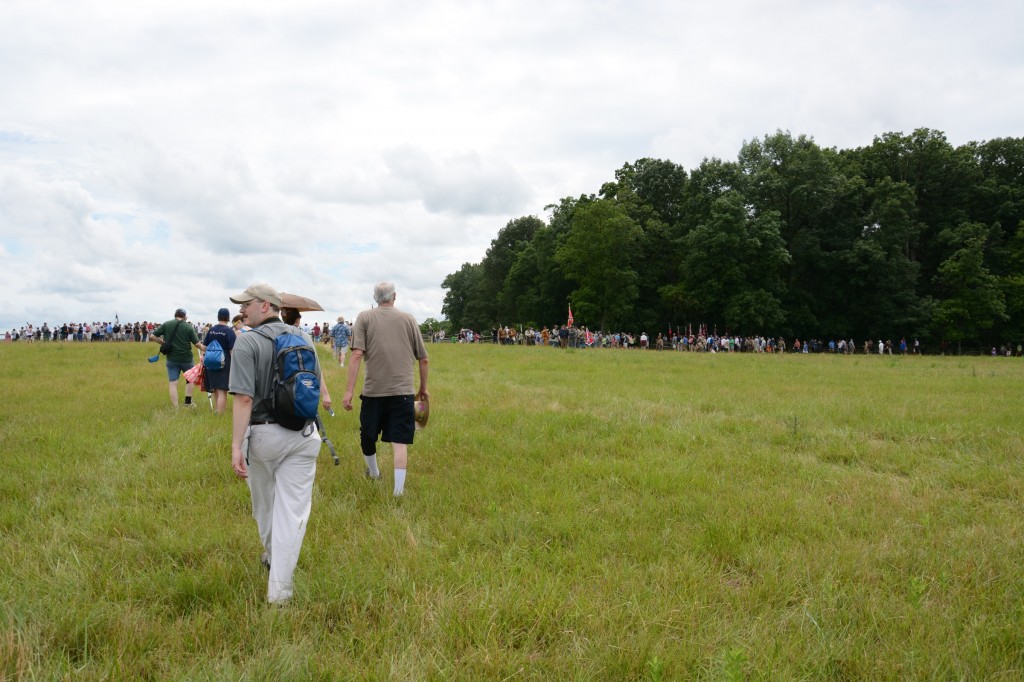
We made it to the other side and found our way to Armistead’s brigade. Not being true southerners ourselves, he was our closest connection to the attack. Brig. General Armistead was the nephew of the man who defended Fort McHenry in Baltimore, and both he and his uncle are buried in our hometown. Being the supporting brigade of the attack, it would also give us an excellent view. Since we were among the last to arrive, we ended up on the far, southern flank of the brigade.
At 3:00pm, the brigades in front of us (Garnett’s and Kemper’s) stepped off, while our own made a left face and started walking in what I considered to be the wrong direction (I assume this was a traffic control measure – there are only so many gaps in the fences). I wasn’t the only one who thought this – we had some living historians right behind us.

As the men in uniform came up through our ranks, one of the visitor’s asked what we were supposed to do. The 1LT above said, “I don’t know what the plan is, but this is what we’re doing!” I don’t know how all of you feel, but if there’s a man with a drawn sword, you FOLLOW THAT MAN!
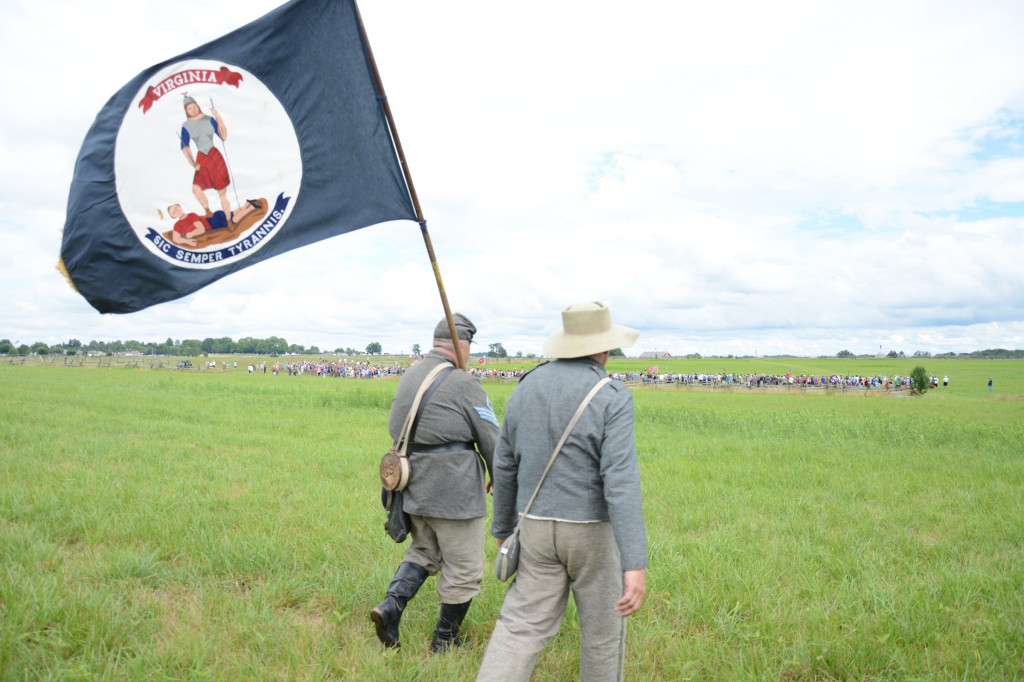
That’s Garnett’s Brigade to our front left.
While there in an unofficial capacity, these guys did a great job with our group. They kept us in line, at times stopping to try to get us reformed more properly. We also learned the proper Rebel Yell for when we got past the Emmitsburg Road.
Here’s our pictures from the charge:
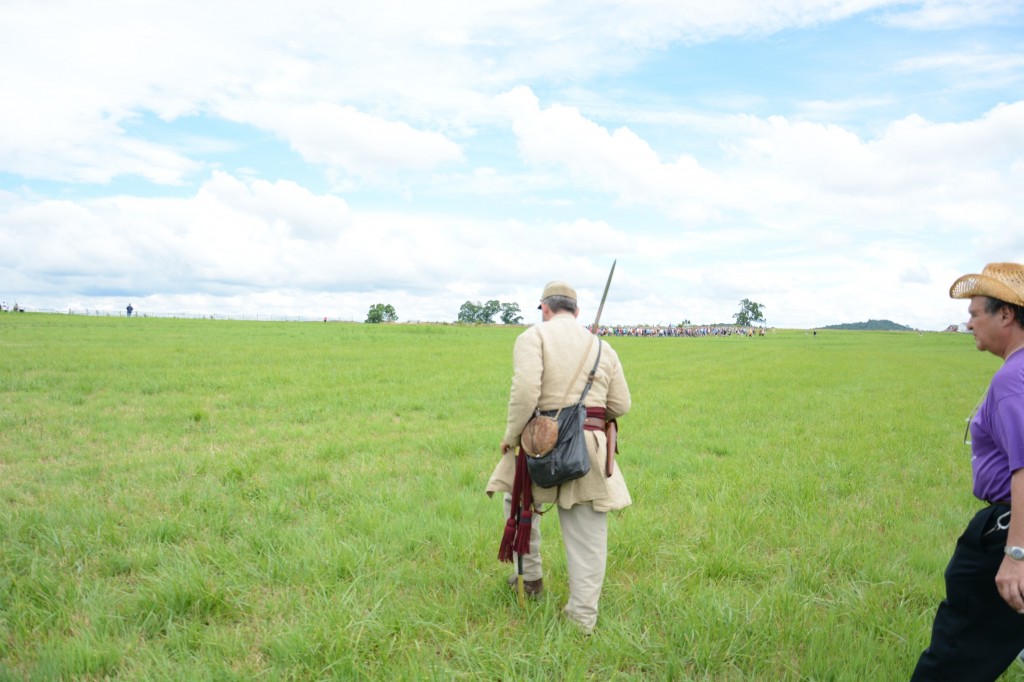
Note the hill on the right – that’s the tip of Big Round Top. We can’t see any of the monuments at this point – not even the massive Pennsylvania Memorial.
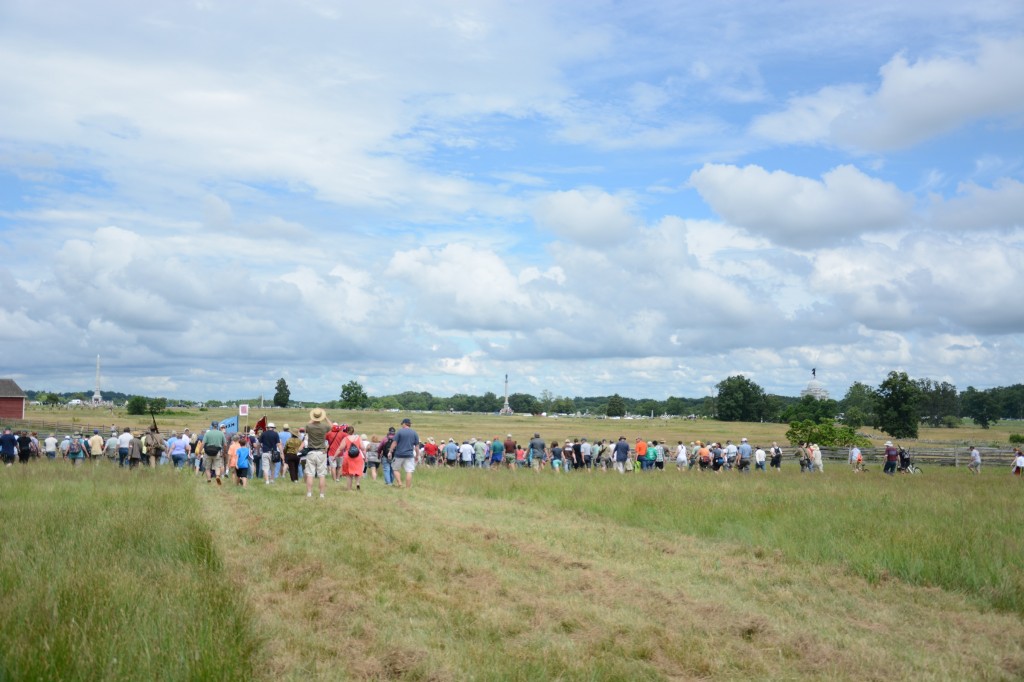
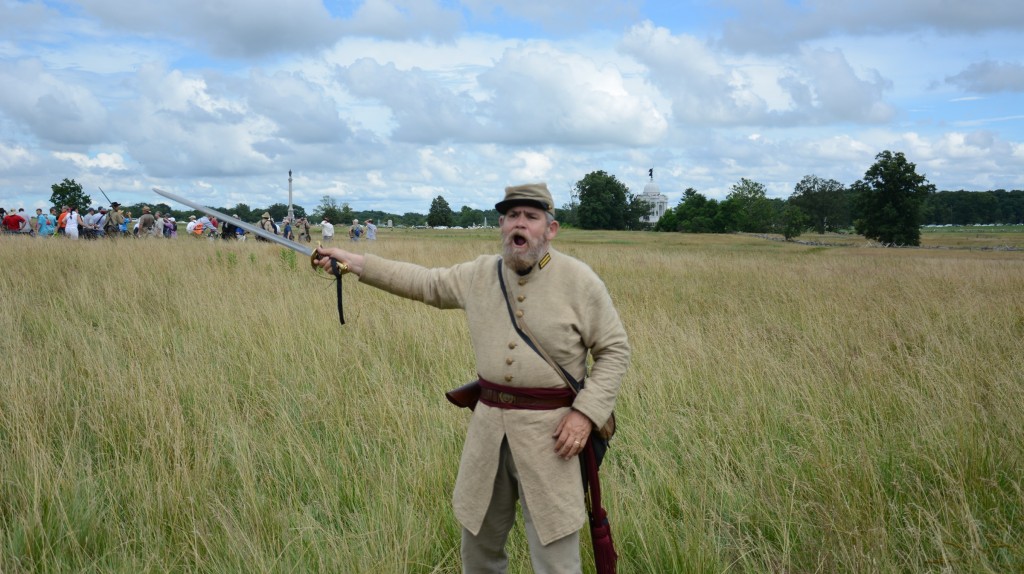
Remember – Listen to the man with the drawn sword, kids!
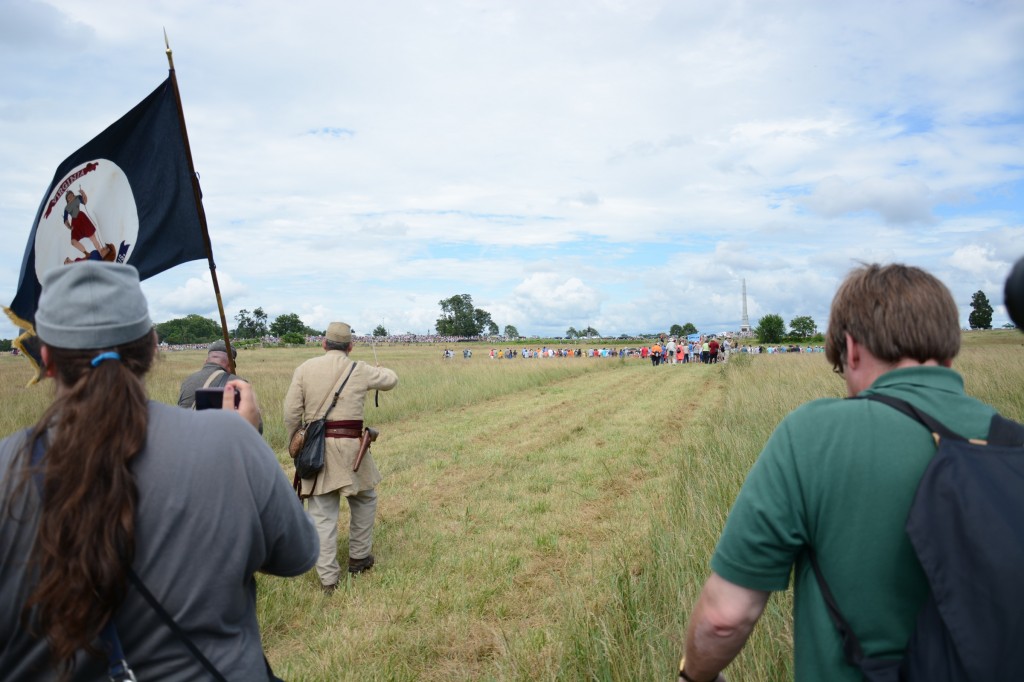
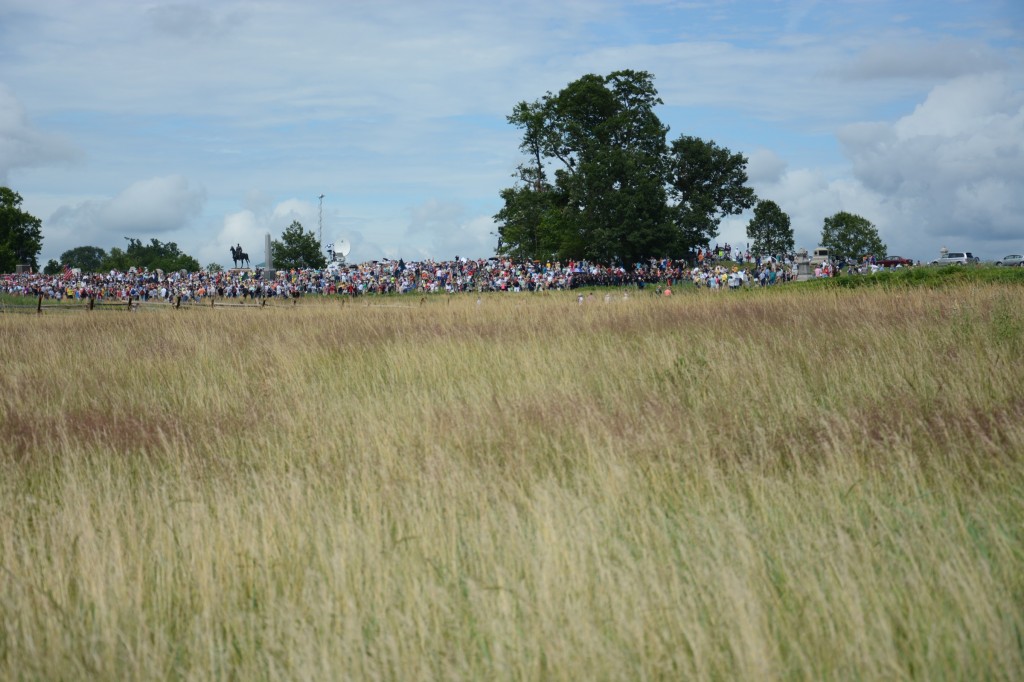
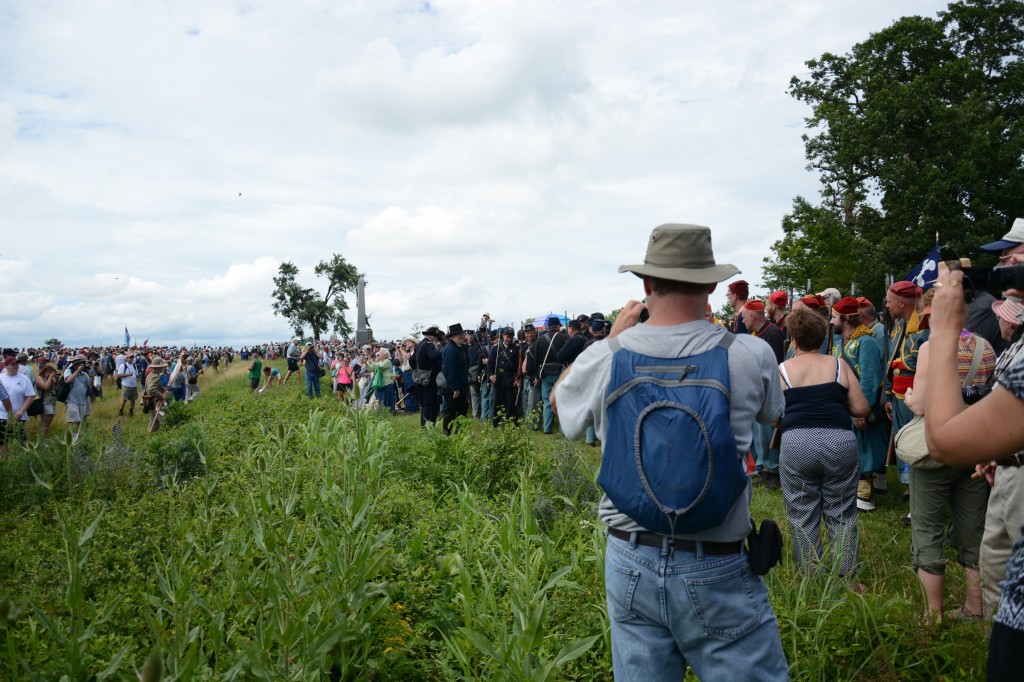
We were ordered to “break ranks”, and by this point, we were glad to.
At the end of the march, we sat down on a rock and broke out some water. People were milling around and taking in the awesome scene that we had all just been a part of. After a few moments, a Union bugler started playing “Taps”. As he finished, another picked up, and all down the line the buglers took turns – 12 in all, I think – playing a tribute to the men who fell 150 years before.
I honestly can’t describe how amazing this whole experience was. Like I said at the outset, Pickett’s Charge is the most well-known part of the Battle of Gettysburg – not exactly something that would feel like a new, amazing experience for a guy like me, but it did. Whether it was being led across by a 1LT who knew his stuff, or that there were thousands of people beside me, or thousands of people in front of me, or that my dad was there; this was a unique and memorable, once-in-a-lifetime experience. The NPS did a FANTASTIC job with this event. If they did this every year, I’d be there.
We couldn’t leave Cemetery Ridge without getting a picture:
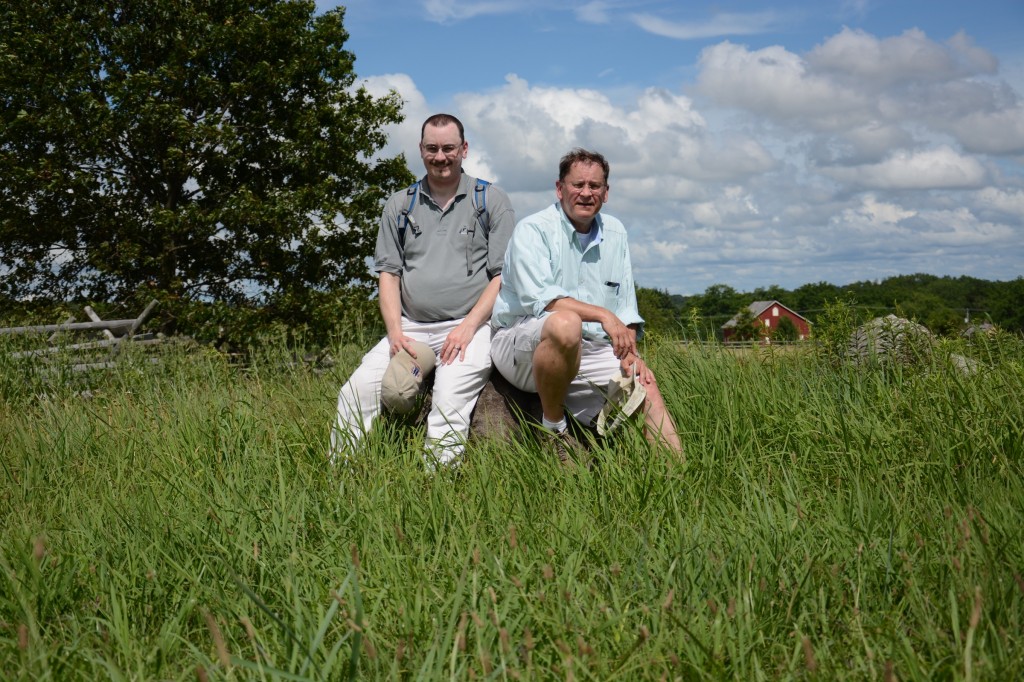
You’d never know it, but we were completely surrounded by 15,000+ people when this was taken.
It was such a tremendous experience, I still can’t believe that I actually got to do it. My thanks go to my dad (for coming along), my wife (for handling things at home while I tramped around a battlefield), and the NPS for putting all this together and making it run so smoothly. I don’t think I’ll ever forget this.
Thanks for the post, Pete. I really enjoyed it.